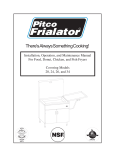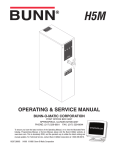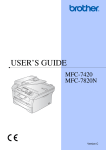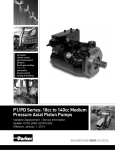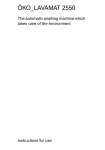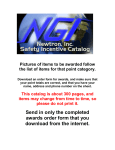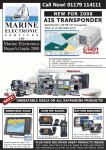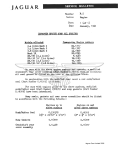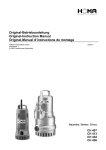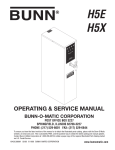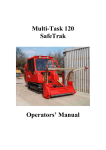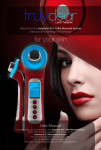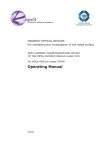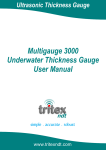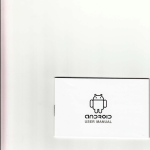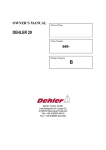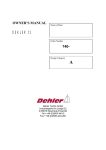Download manual DELPHIA D-33.cdr
Transcript
OWNER’S MANUAL
Copyright law
2008 Delphia Yachts technical data. All rights reserved. This manual was
written in accordance with the standards of International Standard Organisation (ISO)
10240:2004. This manual and none of its components including text, illustrations and
tables cannot be reproduced in any other form without
written permission from Delphia Yachts under the threat of violation of copyright law.
The use of information included in this manal is not restricted by patent laws.
C
Delphia 33 - Owner’s manual
First edition - January 2008
Printed in Poland.
Reservations regarding legal responsibilty
The substantive content of this owner’s manual was checked and approved.
This means that the instructions and Delphia yachts descriptions included in it were up
to date during their production. The next versions of boats and manuals may change
without former notification. Delphia Yachts Company is not responsible for any
disservice resulting directly or indirectly from the mistakes, ommisions and
discrepancies existing between the real boat and infrmation included in this manual.
Trademarks
Dephia is a reserved trademark of Delphia Yachts Sp. Jawna. In the manual may also
appear another trademarks and registered trademarks notmentioned above.
Serial number:.......................
YOUR BOAT
VERSION
.........................................................................
NAME OF THE BOAT
.........................................................................
NAME OF THE OWNER
..................................................................................
ADDRESS
...................................................................................
..................................................................................
..................................................................................
HIN NUMBER
..................................................................................
REGISTRATION NUMBER
..................................................................................
DELIVERY DATE
..................................................................................
KEY NUMBER
..................................................................................
ENGINE
..................................................................................
ENGINE SERIAL NUMBER
...................................................................................
ENGINE KEY NUMBER
...................................................................................
Your agent
DELPHIA YACHTS KOT sp.j. ul. Kościuszki 63 19-400 Olecko -POLAND
Tel. 087 520 30 37 Fax 087 520 21 77
internet : http://www.delphiayachts.pl
TABLE OF CONTENT
Delphia 33
update 01.03.2008r
Total number of pages: 99
INTRODUCTION
Chapter 1......................................................................................................................................page 2
SPECIFICATION
Chapter 2......................................................................................................................................page 6
SAFETY
Chapter 3......................................................................................................................................page 8
DECK AND HULL
Chapter 4....................................................................................................................................page 12
RIGGING AND SAILS
Chapter 5....................................................................................................................................page 21
CABINS
Chapter 6....................................................................................................................................page 30
INSTALLATIONS
Chapter 7....................................................................................................................................page 33
ENGINE
Chapter 8....................................................................................................................................page 49
ELECTRIC SYSTEM
Chapter 9....................................................................................................................................page 61
LAUNCHING
Chapter 10..................................................................................................................................page 90
WINTER STORAGE
Chapter 11..................................................................................................................................page 91
ENVIRONMENT PROTECTION
Chapter 12..................................................................................................................................page 93
WARRANTY
Chapter 13..................................................................................................................................page 94
PERSONAL NOTES
At the end of the manual
EXTRAS
CD ROM including owner’s manual and detailed electric system schemes in PDF
format.
1/99
1
INTRODUCTION
You have just been delivered a brand new Delphia 33. First of all we
would like to thank You for your trust and the choice of one of our products. Each our
yacht is the subject of our particular care in the smallest detail, beginning from the
project, until the moment of shipment and launching of the yacht. All of these is done
in
order to give you joy and delight for many years.
We share the common passion for the sea: we, Delphia Yachts as a
shipbuilders
and You, who want to live your passion on the Seven Seas.
We are delighted to welcome You to the great family of Delphia Yachts boat
owners.
This manual was meant to help You to enjoy your boat comortably and
safely. It
includes the boat specifications, the equipment, the systems and tips on her operation
and maintenance. Some of the equipment elements may be optional.
We keep improving our boats as we want You to benefit from the
technological developments, new equipment or materials and our own experience.
This is the reason why the specifications and information given are not contractual,
they may be modified without prior notification or update.
Our network of Delphia Yachts authorized dealers will be at your disposal to
help You to get acquainted with your boat and will be the most qualified to take care
of her maintenance.
2/99
Even if your boat has been appropriately assigned to a category, the sea
conditions and the wind relating to a category A, B and C are changeable and depend
on the hazards of unusally strong waves or gusty winds. In such conditions only an
experienced, very fit and well equipped crew can sail satisfactory.
ADVICE
Please make sure that the sea and wind conditions will correspond to the
category of your boat and you and your crew are able to handle the boat in
these conditions.
This manual is not the course in safety sailing or sailing in general. If it is your
first boat or if you change to a new type of boat, which you are not used to, get some
training in boat control and sailing to ensure your safety and comfort. Your dealer,
your international sailing association or your yacht club will be very happy to
recommend you local sailing schools or professional instructor.
This manual is not a detailed instruction maintenance or repair. In case of any
problems do not hesitate to contact the producer of the boat or one of his dealers.
3/99
1
The users of the boat are informed of the following:
- The entire crew must be trained properly.
- In some countries a licence or a training course is requested. Make sure you have this
before you use the boat.
- You should always keep the boat in good conditions and take into account that it
wears out with time and inapropriate use.
- Any boat, however solid it may be, may be severly damaged if badly used. This is not
compatible with a secure navigation. Always adjust the speed and direction of the boat
to the conditions of the sea.
- If your boat is equipped with a liferaft, read the instruction carefully. The crew should
be familiar with the use of all safety equipment (harness, flares, liferaft, etc.) and the
emergency safety procedures (MOB, towing, etc. ). Sailing schools and yacht clubs
organize such courses regularly.
- You are not allowed to sail at the maximum speed in busy areas or in case of low
visibility, strong wind or vast waves. Then you should reduce the speed and change
the direction of the boat taking into account your own and others’ safety.
- You should obey the ‘COLREG’, the steering and course regulation rules as it is
described and published by International Maritime Organization. These are the
international regulations in order to prevent collision at sea.
- Make sure if there is enough place for stopping the boat or manoeuvre in order to
prevent the collision.
4/99
Always use an experienced technician for the maintenance of your boat and
introducing any modification.
All the changes which may affect the safety of the boat should be evaluated
and carried out by competent people. The shipbuilder cannot be responisble for the
changes which were not approved.
ATTENTION !
All the changes of the deck load (eg. Adding a lifted platform for fishing, a radar,
mast drop system, changing the engine, etc.) may affect the stability of the boat.
The information regarding the maintenance included in this manual works as
a tips for a boat owner during the normal exploitation of the boat in typical
conditions.
Climate and the methods of use may change and may need additional or
special maintenance. Contact your local Delphia Yachts dealer in order to get the
information regarding the appropriate maintenance and safety precautions advised
for your type of use and climate.
The appropriate maintenance of your boat may give you a lot of satisfaction
during during sailing activities. Regular control is the best preservation. It helps to
secure the boat and maintain it in good condition during the exploitation and
comforts you when you cannot take care of the yacht.
KEEP THIS MANUAL IN A SAFE PLACE AND HAND IT OVER TO THE NEW
OWNER IF YOU SELL YOUR BOAT
5/99
2
SPECIFICATION
Length of hull {m}............................................................................................................................. 10,40
Width of hull {m}................................................................................................................................ 3,47
Length KLW {m}................................................................................................................................. 9,06
Width KLW {m}...................................................................................................................................2,73
Draft to KLW {m}................................................................................................................................ 1,77
Height over KLW {m}...................................................................................................................... 15,40
Boat weight {kg}................................................................................................................................. 5200
Maximum load {kg}............................................................................................................................. 995
Ballast {kg}......................................................................................................................................... 1330
Additional engine power max (KW/HP).................................................................................... 22/45
Fuel tank (litres)................................................................................................................................... 125
Water tank (litres)................................................................................................................................ 210
Waste water tank (litres)....................................................................................................................... 45
Batteries capacity (Amph)........................................................................................ 2x105 +1x75 (12V)
Maximum number of people..................................................................................................................6
Architect............................................................Andrzej Skrzat Delphia Yachts Designer
Sails
Full battened mainsail with two reefs {m²} ....................29,00
Furling genoa {m²}.........................................................................32,00
Spinnaker {m²}............................................................................... 60,00
P {m}................................................................................................ 12,90
E {m}.................................................................................................. 4,10
I {m}................................................................................................. 13,00
J {m}................................................................................................... 3,68
6/99
Certificates and Project Category
DELPHIA 33 was certified (CE) in Polish Ship Registry (PRS)
and Germanischer Lloyd. The procedures for module Aa according to
directive 94/25/WE. The inspection of the unit was in accordance with the
norm PN-EN ISO 12217-2 in the sphere:
● Stability and freeboard
● Displacement and buoyancy
The hull identification number placed on the transom starboard.
DELPHIA 33 has a project category A for 6 people.
Category A - ,, oceanic”: A unit designed for long cruises, during which can appear
such conditions when the wind force exceeds 8 degrees in Beaufort scale and the
significant height of waves is more than 4 metres. It refers to self-sufficient units.
ATTENTION !
Do not exceed the advised maximum number of people. Regardless the number
of people on the boat, The maximum weight of people and the equipment cannot
exceed the maximum load capacity recommended by the boatbuilder. Always use
the seats.
ATTENTION !
When loading a boat, never exceed the maximum load capacity. Do it carefully
and distribute the load properly in order to get a level draft. Avoid placing the
heavy objects in high positions.
7/99
SAFETY
WARNING !
- before you sail, list the compulsory safety equipment
- do not exceed the maximum number of persons indicated in the chapter
SPECIFICATIONS;
- when you do not take into account the maximum number of people,
the total weight of the people and the equipment you may exceed
maximum load recommended by the manufacturer which cause a great
danger
RECOMMENDATION
Close the deck hatches and fore escpe hatch before each sailing trip. In case
of heavy weather close companion hatch.
8/99
3
LOCATION OF THE FIRE EXTINGUSHERS
AND EMERGENCY EXITS
ATTENTION!
The fire extinguishers are part of the compulsory equipment.
There are two dry powder extinguishers on D-33, automatic and manual:
- automatic (1 kg, A26/40)
- manual (2 kg, 13A 89B)
A
- FIRE EXTINGUSHERS
1. Automatic - under the stairs,
on the engine compartment cover.
2. Manual - in the messroom under the seat.
B
- EMERGENCY EXITS
A. Deck hatch of the fore cabin.
B. Companionway.
9/99
The owner’s or skipper’s duty is:
- to check the extinguisher according to the information included in the manual;
- to replace the extinguisher, which is empty or expired;
- to inform the crew where the extinguishers is and how to use it;
- to tell the crew how to behave in case of a fire;
ATTENTION !
NEVER:
- obstruct the way to emergency exits;
- obstruct the access to safety controls (fuel valve, gas valve, power
switches)
- obstruct the access to the fire extinguishers;
- leave a boat unattended when gas appliances are working;
- use gas lamps in the boat;
- modify the boat systems (electricity, gas or fuel);
- change a gas cylinder when an engine is running;
- smoke while handling fuel or gas
ATTENTION!
When sailing always wear a life jacket. In heavy weather conditions
use safety belts and life lines.
10/99
EMERGENCY TILLER
The emergency tiller is in one of a stern lockers. Make sure that there is an easy access
to the tiller.
How to use the tiller:
1. Unscrew the cover of rudder bearing situated under the seat at the back of the cockpit
using a winch handle (photo 1).
2. Insert the tiller into a rudder stock.
3. Make sure that it is properly mounted.
2. Emergency tiller
1. Winch handle
Advice
The emergency tiller should be used only in case of a steering wheel
failure. It was designed only for this purpose that is why the speed
should be reduced when using the tiller.
11/99
4
DECK AND HULL
The construction of the yacht is based on fiber-plass reinforced plastic shell
technology. It consits of three main shells, the deck shell, the hull shell and the
construction
frame shell. In addition there is counter ceiling shell, two sanitary cabin shells and
small
equipment shells. All of them are monolitic constructions and partly stacking care
constructions. The stacking care is a foam Airex type. All the hull elements are
permanently
joined together with a glue and fiber glass reinforced plastic. In places which carry a
heavy load the construction was reinforced with duraluminium plates. All elements
made of wood were protected with a varnish. All elements made of fiber-plass plastic
were protected from water on influance outside with a special polyester resin called
gelcoat, and from inside with polyester resin called topcoat.
12/99
DECK
A
A
B
B
C
C
A
A
A. Cleats
B. Life lines
D
C. Chocks
D. Ladder
13/99
4
MOORING
The proper number of accurate mooring ropes suitably sized and suitable
for the environment shall be on board for mooring the boat.
When mooring you should:
- always manoeuvre your boat using the engine;
- take into account the current wind and tide;
- handle your boat carefully at a reduced speed.
Always keep the mooring lines in clean and dry place.
DANGER !
Do not try to stop your boat by your foot or hand when mooring!
TOWING
Towing another boat:
- pay particular attention when you throw or catch the towing rope;
- tow another boat at a reduced speed and as smoothly as you can.
When you are towed:
- handle your boat gently and try to stay in the wake of the towing boat.
14/99
ANCHORING SYSTEM
D- 33 is equipped with anchoring system consisting of:
-15 kgs Delta anchor;
- windlass;
- 50 metres anchor chain.
ATTENTION !
There should be two crew members during the lowering of the anchor:
- one operating the engine control panel;
- one operating the windlass joystick.
WARNING !
Before anchoring check the depth of water, the power of the current and
the structure of the sea bed.
WARNING !
Do not stop the engine when anchoring in order to avoid discharging of
the batteries.
Lowering the anchor
Stop the boat and stand aline the wind. Going back slowly start lowering the
anchor using the windlass.
In order to start the windlass you should turn on house master switch +
main windlass securing. After turning them on you should go to the bow part of the
boat and lower the anchor using the joystick.
Lifting the anchor
Make sure that the chain is properly placed on the lift. Start the engine and
moving slowly lift the anchor up. After lifting it up you can turn off the windlass
securing. If you know that you will not use the anchor for a long time you can place
it in the anchor chamber.
15/99
4
MAINTENANCE OF THE DECK
First of all, the boat should be washed on shore in order not to contaminate the
water.
Do not use aggressive detergents to wash your boat.
Wash the deck regularly using the water with addition of degreasingl cleaning agents
which you can buy in a marine store. Use as few cleaning agents as possible.
DECK FITTINGS
Clean all the deck equipment with fresh water. Periodically lubricate blocks,
travellers, etc. with a water-repellent grease. Clean and polish the stainless steel parts.
TEAK
Regularly clean the woodworks with fresh water and sponge.
ATTENTION!
Do not use a pressure washer for cleaning the teak parts.
PLEXIGLASS
Rinse plexiglas with fresh water.
Brighten up with a soft rag soaked with liquid parafin.
Use polish paste to remove scratches.
ATTENTION !
Never use solvent, alcohol, acetone and any other liquids based on these
substances to rinse plexiglas.
16/99
STEERING SYSTEM
The boat is equipped with either steering pedestal or steering tiller. The rudder
is placed under the bottom of the boat and is handled from the cockpit. The rudder
blade is made of fiber-glass reinforced plastic.
STEERING WHEEL VERSION
1
7
2
3
8
5
4
6
1. Steering wheel
2. Steering pedestal
3. Rudder stock upper bearing (emergency tiller mounting place)
4. Rudder stock lower bearing
5. Crow-bar
6. Rudder blade
7. Emergency tiller
8. Rudder stock
17/99
TILLER VERSION
2
1
4
3
5
1. Tiller
2. Rudder stock upper bearing
3. Rudder stock lower bearing
4. Rudder stock
5. Rudder blade
18/99
4
HULL
MAINTENANCE OF THE HULL
The materials and the equipment of your boat are of the best quality in order
to be the most functional and easy to maintain. They have been chosen to protect the
outer layer of the hull from outside attacks (salt, sun, electrolysis, etc.). This means
that the minimum maintenance is enough to keep the hull in perfect condition.
If it is possible, wash your boat on shore.
Use as few cleaning agents as possible.
Do not use aggressive detergent agents or solvents.
Do not discharge your cleaning products into the water.
19/99
ANTIFOULING
M MSC =4880kg
B
A
SBO
C
A- water line
B- deck line
C- antifouling (red colour)
The underwater part of each boat should be protected with antifouling paint
because straggleing of the boat reduces its speed. Nowadays there is a wide choice
of protection paints and the purpose of their use is adjusted to the different types of
water. After the year of exploitation of the boat, the bottom of the hull must be painted
with a antifouling paint.
It is advised to conserve the hull at least once a year (covering the hull surface
under the water line with a preservation paint). An epoxy coat is recommended for this
purpose.
Remember that any excessive sanding before the antifouling paint attacks your
gel coat and impairs its reliability.
Your boat may regain its shine as new if reglarly polished.
20/99
5
RIGGING AND SAILS
The main drive of the boat are triangular sails consisting of genoa and
mainsail.Additionally, the boat may be equipped with two jibs and spinnaker.
The sails are mounted on the mast made of duraluminium profile reinforced with
wire ropes. The mast is situated on the deck over the pillar.
STANDING RIGGING
1
5
4
6
3
2
7
J=4520
1
Forestay
Ø 7 mm
2
D1
Ø 7 mm
3
V1
Ø 7 mm
4
Spreader shroud
Ø 5 mm
5
Top mast shroud
Ø 7 mm
6
Backstay
Ø 6 mm
7
Bridle
Ø 6 mm
21/99
MAST INSTALLATION
Before mast installation:
- protect the mast against possible damage during unloading;
- tie down the shrouds and all the rigging to the base of the mast.
ATTENTION!
Before you lift the mast, make sure that there is enough space
and it is clear (no electric cables, etc.)
During mast installation:
- take all the necessary steps to avoid damaging the mast equipment;
- put the mast on the mast support;
- make sure that the base of the mast integrally bears on its base plate;
- lift the mast using a mast drop system;
After mast installation:
- install the standing rigging (check the tightening and position);
- check the tightening of the fastening pins on the rigging screws;
- mount the boom;
- mount the topping lift and tighten it until the boom is perpendicular to the mast;
- reconnect the electric cables;
- adjust the mast after a few trips.
MAINTENANCE OF THE MAST
Before each trip carefully inspect the mast from the top to the bottom.
Periodically check the rigging tightening and the rest of the mast elements (you should
check it for the first time after a few days of sailing in different types of weather).
From time to time you should lubricate the rigging screws with graphite grease
and inspect them for possible wear. Change any shroud or stay with severed wires.
DANGER !
In order to repair or inspect the mast during sailing, you can lift one of your
crew member to the top of the mast. Remember not to use connected halyards
for this purpose and not to do it in heavy weather conditions.
22/99
5
RUNNING RIGGING
1. Mainsheet traveler adjustment8 mm
2. Mainsail furlex- 10 mm
3. Spinnaker boom kicking strap- 12 mm
4. Mainsail halyard- 12 mm
5. Mainsail sheets - 12 mm
6. Spinnaker boom halyard- 10 mm
7. Spinnaker halyard - 12 mm
8. Genoa halyard- 12 mm
9. Fore sail sheets - 14 mm
10.Spinnaker sheets- 12 mm
11.Genoa furlex- 10 mm
RUNNING RIGGING MAINTENANCE
- regularly lubricate the sheaves;
- change any distorted or dented sheaves;
- reglarly check the jaw cleats condition;
- replace the ropes which are worn out;
- regularly clean the blocks (waste grease, corrosion);
- check the winches regularly.
WARNING!
Refer to the manufacturer’s instruction to remove the winches and put them
back. Improper refitting may result in accidents.
23/99
SAILS
1. Genoa - 29,00 m 2 - red colour
2. Mainsail - 32,00 m 2 - green colour
3. Spinnaker * - 60,00 m 2 - blue colour
4
1503
*-Additional option
24/99
5
ATTENTION !
Regularly check the condition of the sails
ADVICE
After the end of a sailing season leave your sails to a specialist to carry out
accurate maintenance and repairs.
During the first trips trim the sails properly in order to reduce the harmful
strains on them. napięcia na ich strukturze. In order to avoid tears and wear you
should secure the elements with rough surface. Between the trips, slack away the
halyards and the mainsail foot tuning line.
CLEANING AND MAINTENANCE
Rinse your sails from time to time with fresh water without any detergents
and dry them quickly in order to avoid mildew. Avoid drying the sails on the
mast because you can make the seams worn and the sails may be torn by the
rigging. To remove grease stains use special substances for this purpose which
you can buy in marine store.
SAIL STORAGE
Store the sails in a special bag that you received together with the sails.
Remember that the sails must be dry in order to prevent mildew from apperaing.
PROTECTION
If the sails remain on the mast for about 24 hours protect them from UV rays
with a cover placed on the leech and foot of the furled sails. UV rays are harmful
to polyester and nylon.
25/99
8
white
red
white
8 Mainsail sheets
9 Lazy jack
12
8
12
10
white with blue-yellow stripe
white with blue-yellow stripe
red
5 Mainsail halyard
6 Topping lift
7 Mainsail traveler halyard
14
10
white with multicolour stripe
3 Mainsail foot tuning line
4 Gas kicking strap halyard
12
12
Diameter {mm}
white with multicolour stripe
Colour
white with multicolour stripe
2 Reef 2
1 Reef 1
Running rigging description
RUNNING RIGGING FOR CLASSIC MAINSAIL
26/99
Colour
White
Red
Green
Mainsail sheets
8
10 Mainsail furlex halyard *
white with blue-yellow stripe
White with blue-yellow stripe
red
white with multicolour stripe
Mainsail traveler halyard
Mainsail halyard
Topping lift
Mainsail foot tuning line
Gas kicking strap halyard
Running rigging description
6
7
5
4
3
10
10
8
12
14
10
12
Diameter {mm}
RUNNING RIGGING FOR FURLING MAINSAIL*
27/99
28/99
14
10
12
White-blue
13 Genoa halyard
Diameter {mm}
White-black
Colour
Blue
11 Genoa sheets
12 Genoa furlex halyard
Genoa rigging description
RUNNING RIGGING FOR GENOA
16 Babaerholer
17 Spinnaker halyard
18 Spinnaker boom halyard
Spinnaker rigging description
14 Spinnaker sheets
15 Spinnaker boom kicking strap
10
12
10
White-yellow
12
12
Diameter {mm}
blue
White-red
green
White-red
Colour
RUNNING RIGGING FOR SPINNAKER
29/99
CABINS
D- 33 2 CABINS
1
1
2
2
CABINS- blue colour
30/99
6
D- 33 3 CABINS
1
1
w.
c.
2
3
2
3
CABINS- blue colour
31/99
MAINTENANCE
INTERIOR
- Take the advantage of fine weather to take the settee and berth cusions out.
- Use blinds to protect the inside ofthe boat against UV rays.
- Be careful during vacuuming in order not to damage anything.
INSIDE VARNISH
-Rinse the inside varnish with fresh water mixed with spot remover and shampoo.
-It is advised to polish the inside varnish with shammy leather.
FABRICS (stain removal)
- Remove as much stain as you can with a knife blade.
- Dab with a clean rag.
- To remove the stain completely, use solvent on a clean rag. Never pour the solvent
directly on the stain.
- Then rub with a clean and dry rag.
- Brush the fabric against the grain.
- Use the vacuum cleaner when the fabric is dry.
LEATHER
- Use a leather cream for ordinary care of leather fabrics.
- Do not use detergents.
- Do not use silicon based products.
- Clean with a sponge and water with soap.
- Remove the grease stains with appropriate products (e.g. talcum powder).
32/99
33/99
BILGE SYSTEM
Nr:
1
2
3
4
5
6
7
8
9
10
11
12
13
14
15
16
17
18
19
20
21
22
23
24
25
26
27
28
Blilge system scheme description
Discharge of water from auto-manual bilge pump
Discharge of water from manual bilge pump
Discharge of water from the boiler and shower pump
Manual bilge pump
Waste water tank outlet valve
Waste water tank vent
Waste water tank intake
Toilet manual pump
Toilet sink outlet valve
Shower pump
Shower pump filter
Toilet water intake valve
Deck wash inlet valve*
Fresh water tank vent
Fresh water tank intlet
Discharge of water from anchor chamber
Connector*
Fresh water tank
Deck wash pump*
Auto-manual bilge pump suction pipe
Manual bilge pump suction pipe
Bilge pump filter
Auto-manual bilge pump
Kitchen sink outlet valve
Salt water foot pump*
Salt water inlet valve*
Engine
Boiler
34/99
BILGE PUMP SYSTEM
In bilge pump system for D-29.2 there are two bilge pumps:
- auto-manual bilge pump (electric);
- manual bilge pump (manual).
AUTO-MANUAL BILGE PUMP
Pump model: JABSCO 37202-2 10A (120W).
Auto-manual bilge pump, as the name indicates, has two functions:
automatic and manual. When you want to use the automatic pump
you should turn on on the switchboard panel
bilge auto-manual fuse,and then on the
pump panel (photo 1) turnthe switch to
auto position. In order to use the manual option
you should turn the switch on the pump panel
to manual position.
1. Bilge pump panel
2. Auto-manual bilge pump
3. Bilge pump suction pipe and sensor
MANUAL BILGE PUMP
Manual bilge pump with the output of 50 l/min.
Is located on cockpit starboard. Bilge suction pipe
is located under the floor in the messroom. Remember
to always have an easy access to the pump lever.
The distribution of particular elements of bilge pump system on the boat-refer
to bilge system scheme on page 33.
35/99
7
OUTLET VALVES IN THE TOILET
Waste water tank discharge valve
Sink outlet valve
Opened valve
Closed valve
SANITARY APPLIANCES
TOILET
- Before using the toilet check if the water inlet valve is opened.
- In order to avoid clogging the toilet use absorbent paper only.
- Rinse the toilet regularly with fresh water.
- Close the valve after each use.
SINK AND SHOWER
- Close the valves and turn of the taps after each use.
-Remove the water from the shower cabin using the shower pump.
Regularly check the level of waste water in the tank using DCT/LM indicator.
The distribution of particular elements of sanitary appliances - refer to the bilge
system scheme from page 33.
36/99
TOILET INSTALLATION SCHEME
A
B
C
D
E
A. Waste water tank outlet (use to empty the tank in a marina)
B. Tank vent hole
C. Waste water tank
D. Waste water draining valve (use to empty the tank in open sea)
E. Outboard water intake
The distribution of particular elements of toilet installation - refer to the bilge system
scheme from page 33.
37/99
Hot water
Cold water
water intake hose from the tank to the pump
38/99
Fresh water installation scheme description
Tap- outboard shower
Boiler
Tap in the toilet
Tap in the kitchen
Fresh water pumpwith filter
Nr:
1
2
3
4
5
FRESH WATER INSTALLATION SCHEME
7
FRESH WATER TANK
- Fresh water tank is made of stainless steel and has the capacity of 215 litres
- Do not fill up the water and fuel tank at the same time.
- Regularly check the tightness of water tank inlet plug.
The water filler is located in the bow
part under the anchor chamber cover
MAINTENANCE
- Pay attention to the quality of the water for filling up, Check if it is drinking water.
- Sterilize the tank periodically. Use only special products for this purpose, which you
can buy at the Chemist’s.
- If the boat has not been used for long, you should purify the tanks and pipes with acetic
acid or white vinegar.
- Do not use chlorine-based liquids beacuse they may weaken the material that the
tanks are made of (stainless steel)
Advice
- Do not use the water system appliances when the valve is closed or the tank
is empty.
- Regularly check the water filter condition.
- Close the valves when the tank is completely empty.
39/99
SEA WATER INTAKE AND DISCHARGE
INSTALLATION IN THE MESS *
1. Sink outlet valve.
1
2
Opened valve
Closed valve
2. Sea water foot pump.
*-Additional option
40/99
7
3. Sea water intake valve placement.
The distribution of particular elements of sea water intake and discharge installation- refer to the bilge system scheme on page 33.
41/99
DECK SHOWER*
In order to use the deck shower you should turn on
shower pump securing on the switchboard panel and then
turn on the pump with a switch (photo 1) located in the
bow locker (anchor chamber). Just next to the switch there
is a connector pipe (photo 2) to which you should connect
a wash-deck hose. Before turning the pump on remember
to check if the water intake valve is opened.
1
2
The distribution of particular elements of deck shower is shown on the bilge
system scheme on page 33.
*-Additional option
42/99
Gas copper pipe
43/99
1
2
3
4
5
6
Nr:
Gas outboard outlet
Gas tester
Reducer
Valve
Gas cylinder
Valve on gas installation
Gas installation scheme description
GAS INSTALLATION SCHEME
7
w.c
.
GAS VALVE
1
2
1. Installation valve under the cooker
2. Gas cylinder valve
Opened valve
Closed valve
The distribution of particukar elements of gas system - refer to gas installation scheme
on page 43.
44/99
GAS CYLINDER LOCKER
Tester
TESTER
Tester is used to check the hermeticity of gas installation.
In order to check the hermeticity you should:
1. Open all the gas valves (with connected gas cylinder).
2. Push the red button on the tester and hold for several seconds
(there should be glicole in the small tank).
If the air bubbles does not appear in the tank at that time, this means that the installation
is hermetic.
45/99
GAS SYSTEM SAFETY INSTRUCTION
If you do not use gas appliance, close the gas valves. When changing the
cylinder the valves should also be closed.
In case of a gas leak, close the cylinder valve and repair the system before
you use it again. The repair must be carried out by a qualified person.
Never obstruct the fast access to the components of gas system.
The valve of empty gas cylinders should always be closed and disconnected.
Keep the protection, lids, covers and taps in their places. Store the spare cylinders
on the deck or in a locker with a ventilation to the open air.
Do not the gas cylinder storage place to store any other equipment.
Regularly check (at least once a year) the rubber hoses and replace them if
needed.
Do not use the cooker when there is possibility of big rolling angle or the
constant inclination angles (if the unit is not fitted with a cooker with cardan hanging).
ATTENTION !
- Do not use liquids containing ammonia;
- Do not use a flame to detect leaks;
- Do not smoke, do not use a naked flame when you change the gas cylinder.
WARNING !
The appliances that burn gas in naked fire use oxygen of the cabin
and release combustible gases to the inside of the unit. Ventilate
the cabin when using appliances. When using appliances open
the air vents.
Do not use the stove or the oven as heaters.
WARNING !
Never use an appliance unattended when it is working.
46/99
47/99
STATIONARY HEATING INSTALLATION SCHEME
STATIONARY HEATING SYSTEM
(WEBASTO)*
Webasto heating system description
Air intake
Webasto
Cambustion gas outlet
Webasto fuel tube
Hot or cold air outlets
Webasto power suply fuse (in the switchboard)
Control panel and webasto temperature sensor
Fuel tank
Fuel pump
1. Webasto control device.
2. Stationary heating system power supply
fuse located in switchboard locker.
*-Additional option
48/99
ENGINE
D-33, depending on the customer needs, may be equipped with
one of the two types of engine:
1. Stationary engine S-drive;
2. Stationary propeller shaft engine;
ATTENTION !
Read the engine manual before starting it for the first time.
49/99
8
23
ENGINE INSTALLATION SCHEME
50/99
25
51/99
8
Engine installation scheme description
Engine compartment ventilation outlet
Engine cambustion and water outlet
Fuel tank inlet
Tank vent hole
Fuel tank
Closing valve of the fuel system
Fuel excess pipe
Sea cooling water engine inlet valve
Boiler water circuit valve
Engine compartment ventilation inlet
Silencer
Water heater
Fuel filter
Sea water filter
Engine compartment fan
Emergency fuel cut off
Shifter
Revolution level string
Gear level string
Engine cooling system vent hole
Engine cooling system water vent inlet
Engine vent water outlet to bilge
Tank check hole and fuel sensor
Level tank of cooling liquid
Engine control panel
52/99
ACCESS TO THE ENGINE
The engine is installed under the stairs. The stairs have been designed to
enable the access to the engine after their deinstallation. Additionally in stern cabins
there is back and side control hatch. After unmounting of all the hatches and the
stairs you will get full access to the engine.
The stairs are secured with two locks
The stairs
Back hatch
The control hatches open
with a key.
Side hatch
BE CAREFUL !
.
Stop
the engine before you open any of the hatches
When you need to inspect the engine while it is running you should:
- do not get close to wedge belts and other moving parts;
- be extremely careful if you wear loose clothes, long hair, jewelery;
- wear protection clothes (e.g. Gloves).
53/99
8
COOLING THE ENGINE
WITH SEA WATER
In case of S-drive engine sea water is taken through the wholes placed on the
gearbox (photo 1.1), whereas in case of propeller shaft engine goes through the whole
in the hull of the boat (photo1.2). Then the water goes through the valve (photo 2) and is
directed to water filter (photo 3). From the filter it goes to water pump (integrated with
the engine),and from there going through the vent hole (photo 4) the water finally gets
to the cooling system inside the engine.
1.2. Propeller shaft engine water
inlet hole with valve.
1.1. S-drive engine sea
water inlets..
4. Vent hole
2. S- drive sea water inlet valve.
3. Water filter
54/99
USE OF ENGINE
TECHNICAL CONTROL BEFORE STARTING THE ENGINE:
- check oil levels;
- check cooling liquid level;
- open the fuel valve;
- turn on the power;
- check if the warning systems work;
- start the engine;
- check if the control intruments show the right values;
- check if there are any leaks on the engine or any of its parts;
- check the control instrument values;
- check if the engine achieves the nominal revolve speed.
ATTENTION !
Never turn off the power when the engine is running.
MAINTENANCE
ATTENTION !
All the information concerning the maintenance are presented in the
engine manual.
OWNER’S DUTY
All the activities concerning maintenance such as oil and filters change
should be noted. The recordings concerning maintenance are necessary to describe
the warranty cover and should be handed to next owners of the boat.
55/99
8
FUEL TANK
REFUELLING
When refuelling the fuel try not to spill the fuel over the deck because it may cause
the parmanent decolourizations on the deck structure. In order to avoid that cover the area
around the filler with a rag (piece of clothing). Doing that you will prevent the fuel from
getting to the water, which is very important for environment protection.
Fuel filler
DANGER !
Do not fill the fuel when the engine is running!
MAINTENANCE
ADVICE
- Regularly check the tightness of the fuel filler to prevent the water from
getting to the fuel tank.
- Do not cut off the fuel inlet to the engine whent it is not used
(only in the case when the boat is not used for a long time).
- After the end of sailing season clean the tank to get rid of dirt, deposit and
the rest of the fuel.
- Do not clean the fuel tank with chlorine based liquids because it may badly
affect the stainless steel, which the tank is made of.
- At least once a year conduct a detailed inspection of fuel system (tubes,
valves).
56/99
ANTICORROSION PROTECTION
One of the main problems which boat owners face is electrochemical
corrosion. There are countries where there are many motor and sailing boats docking
in marinas at the same time using the shore power. The result of this may be a giant
link. Among the factors which helps in development of corrosion process there are
wandering currents from DC (12V) i AC (230V) installations and the fact that not all
installations on the boats or in marinas work properly.
Pic. 1 The flow of voltaic current as an effect of
connection of two earthing systems of both
yachts through PE on shore.
It may be claimed that even properly installed and not modified simple 115/230 V
AC installation after connection to shore power supply becomes an invitation for
complicated corrosion processes which may be harmful to the boat. Finding a
solution preventing the corroson process and at the sae time not reducing the
effectiveness of anti electric shock crew protection is a real challenge.
The simplest solution which is practiced on some boats is disconnection of
the PE cable (protection cable) from the earthing DC system. Doing that you cut off
the connection of one element of the link with earthing PE cable on the shore, and the
way for voltaic current cut off as well. After mooring to the quay and connecting to
the shore power, the protection cable of the boat installation is connected to its
equivalent on the shore and provides effectiveanti electric shock protection.
The rules of the biggest sailing tycoon, the USA, demand the PE cable to be
connected to the main earthing DC installation minus pole (see pic.1 p. 108). In
Europe, according to the current standards for boats concerning the low voltage
electric installations (PN-EN ISO 10133) and alternating current (PN-EN ISO 10297),
this is not necessary. It is enough to install a differential circuit breaker or separating
transformer in the main AC installation circuit. Then, AC and DC installation do not
have to be connected to the earthing system together. The PRS rules concerning the
classification and building of yachts and motor boats in the chapter describing the
requirements for installations and electric appliances of higher than safe voltage, say
at the same time about the necessity of permanent connection of each metal elements
(which may be under voltage) to earthing system. In case of commonly used on
yachts and boats the energy division system TN-S, it is realized by the means of PE
cable which isconnected to each power socket.
57/99
8
The differential circuit breaker works on the princple of summing up the
current amperage in every working wire. If the currents are summed up and give zero
result, this means that no current goes from the circuit to the “Earth”. If the sum of
currents is different from zero and the value of differential current causes a threat of
electric shock, then the differential circuit breaker breaks such a circuit, including N
cable. The differential circuit breaker reacts to harmful current going to ‘Earth’, PE
cable, through insulation or human body. This breaker is equipped with test button
“T” and you should remember for your own safety to test the breaker once a month.
The inquires included in this sub-chapter only indirectly regards the safe
exploitation of 115/230V AC installation on yachts. The main purpose is to show the
influence of electricityon the phenomenom and process of corrosion.
Each metal elements of the yachts which are under water are especially under
the threat of corrosion process. Cathode protection is used to protect underwater metal
equipment. This is commonly perceived as the most effective method of metal
construction protection in natural electrolytic environments.
The cathode protection is based on the connection of protected constructions (in
case of our yachts it is mainly propeller) with a less quality metal creating the anode
(pic.2 p. 109) of the circuit where the cathode is the protected circuit. With time,
depending on the enviro-nment (high salinity and temperature helps the corrosion
process) and other factors, the anode is getting smaller, it just melts down.
D-29.2
Anode (protector)
Pic. 2. The flow of voltaic current in case of using the
protectorand disconnecting the protection cable
from DC installation.
58/99
We do not need to say how important is efficient cathode protection to
mantain a good technical condition of propeller. Regular control of protectors
(anode) is necessary before the start of sailing season and in the middle of it. It is also
advised to check the efficiency of cathode protection by doing electric measurements
(refer to control processes below). In case when the volume of protectors is reduced
by half, they should be replaced with new ones. If the consumption is not significant,
you can leave the same protectors for the next season. In order to get more detailed
information concerning the replacement of the anode you should refer to manual
which is attached to the engine.
ATTENTION !
On salt waters you should use zinc anodes and on fresh waters you
should use magnesium anodes.
ANTI CORROSION SECURINGS CONTROL PROCESSES:
- check if there is no electric passage in S-drive engine, this means: with 12V master
switches turned off touch the engine column with one tester pin and the gearbox with
the second pin (photo 1). If the tester shows any
value (different from the the one on the photo)
this means that there is electric passage between
the column and the gearbox. This problem should
be immediately reported to the dealer or the engine
manufacturer.
1
In both situations the switch of
the tester should be postioned
as presented on the photo
(0- 200).
- check the galvonic insulator which is installed in the right stern locker
(photo 2), in 115/230V circuit protection cable
between the power dock and differential circuit
breaker. If the tester shows the value as on the
photo, this means that the insulator works
properly. In case when the result is different, this
means that the galvonic insulator does not work
properly.
2
59/99
FIGHT AGAINST FIRE
What should you do in case of a fire in the engine compartment:
- Stop the engine.
- Switch off power and stop fuel supply.
- Use the extinguisher to fight the fire.
- Wait a moment because there is a risk of starting another fire.
- Start the repair if it is possible.
In case when you cannot stop the engine with a control panel, you should use
the emergency fuel cut off (pic. 2).
1
2
1. The fuel cut off valve
2. Emergency fuel cut off handle
A detailed scheme and description of engine installation is shown on pages: 50, 51.
60/99
9
ELECTRIC SYSTEM
RECEIVERS DESCRIPTION
Master switch
Cabin lamp
Red navigation lamp
Green navigation lamp
Pump engine
12V socket
Automatic circuit breaker
Switch
Distribution bus
Radio stereo CD
Speaker
230V socket
Differential circuit breaker
Charger
Boiler
Aft navigation lamp
Fan
Fuse
Shunt
Windlass electric engine
Thruster electric engine
Transmitter
Battery
Fridge
Antenna
Sensor
VHF radio
Switchboard
Webasto
Additional option
CABLES DESCRIPTION
r- Red
n- Black
b- Blue
j/v- Green-Yellow
m...-Brown
r352
Cable diameter
Cable colour
61/99
SWITCHBOARD PANEL D-33
Switchboard description
Cabin lights fuse
Fresh water pump fuse
Shower pump fuse
Bilge auto-manual fuse
Anchor light fuse
Navigation lights fuse
Steaming light fuse
Deck light fuse
230V instalation fuse
Reverse polarity lamp
Battery charger fuse
Boiler fuse
Fridges fuse
Instruments fuse
Radio VFH fuse
Free
62/99
63/99
ELECTRIC INSTALLATION SCHEME D-33
Bateria startowa
12V 75 ah
Bateria steru
strumieniowego
12V 100 ah
9
Electric installation scheme description
Navigation light fuse
Red navigation lamp
Green navigation lamp
Stern navigation lamp
Compass Olimpic 135
Top lamp fuse
Top lamp
Running engine lamp fuse
Running engine lamp
Deck light fuse
Deck lamp
Deck wash down pump and shower pump fuse
Shower Jabsco 37202-2 pump
Johnson pump WPS 5.0
Windlass pilot fuse
Windlass pilot
The windlass chain counter (additional option)
Electric toilet pump fuse
Electric toilet pump Jabsco
Electric toilet pump Jabsco
Fresh water pump fuse
Fresh water pump Johnson WPS 5.0
Fridge fuse
Messroom fridge
The fridge TC-07 in cockpit
Fan fuse
Fan
12V socket fuse
Socket 12V
Navigation instrument fuse
Smart pilot S1 system
C-80
VHF fuse
Ray54E Marine VHF radio
Cabin light fuse
Cabin lamp
Cabin lamp
Cabin lamp
Neon lamp
Cabin lamp
Cabin lamp
Cabin lamp
64/99
Cabin lamp
Cabin lamp
Cabin lamp
Cabin lamp
Cabin lamp
Cabin lamp
Cabin lamp
Stereo radio fuse
Radio stereo CD
Electric cooker fuse (option)
Electric cooker (option)
Auto-manual bilge pump fuse
Bilge pump floating switch
Auto-manual bilge pump
Webasto fuse
Webasto Air Top 3500
Bowthruster battery 12V 105Ah
Start battery 12V 75Ah
House battery12V 105Ah
House battery 12V 105Ah
Battery charger Quick 12V 45A
Shunt
Windlass
Minus ditribution bus
Windlass automatic switch
Windlass relay
Starter
Alternator
Engine control panel
Engine
Bowthruster
Float switch
Bowthruster fuse
Bowthruster isolator
Engine battery isolator
Emergency isolator
House battery isolator
Relay VSR 125A
Relay VSR 125A
House battery test panel bep marine 600-DCT/LM
Switchboard fuse
Automatic or manual bilge pump operation switch
65/99
Windlass
Windlass
fuse
80A
B3
HAR
HAR
-12V
Bow thruster
6B
7L
+12V
B2
Volvo engine
s-drive
fuse 40A
+12V
Switchboard
Second battery
positive +
Sense battery
positive +
VSR Relay
B2
Engine power supply
House master
switch
Emergency master
engine switch
Dipolar engine
master switch
Engine power supply
Fuse 250A
B3
Bow thruster
AL
T2
M
VSR Relay
House
battery no.2
Second battery
positive +
Sense battery
positive +
+3
Start battery no. 1
House battery
12V 100 ah
+
HAR
Start battery
12V 75 ah
+
Start battery no. 1
Bow thruster
battery
12V 75 ah
+
-
-
-
6B
7L
PICTORIAL DIAGRAM OF ELECTRIC INSTALLATION MASTER POWER SUPPLY D- 33
ALT2+3H
66/99
HAR
-12V
67/99
yellow TLM
purple F+PW
red F
Fuel tank sensor
Fresh water tank sensor
Waste water tank sensor
12V DC
FUEL
WATER
WASTE
DC/TLM METER
INTERFASE MODULE
WASTE TANK TLM
SENDER
switch
Switchboard panel backlight
Bilge pump panel backlight
SENSORS CONNECTION
68/99
ELECTRIC WIRE WAYS AND
RECEIVERS PLACEMENT
wires in the hull
wires in the deck
Electric installation scheme description
Switchboard
Red navigation lamp
Green navigation lamp
Stern navigation lamp
Top lamp
Running engine signaling lamp
Deck lamp
Shower pump Jabsco 37202-2
Johnson pump
Bilge pump floating switch
Auto-manual bilge pump
Electric toilet pump Jabsco
Electric toilet pump Jabsco
12V socket
Fresh water pump Johnson WPS 5.0
Fridge
Engine compartment fan Jabsco 35515-0010
Raymarine ST60+Wind St60+ tridata instrument
Smart pilot S1 systems
C-80
Compass Olimpic 135
Ray54E Marine VHF radio
Cabin lamp
Cabin lamp
Cabin lamp
Cabin lamp
Cabin lamp
Cabin lamp
Cabin lamp
Cabin lamp
Cabin lamp
Cabin lamp
Cabin lamp
Cabin lamp
Neon lamp
Cabin lamp
Cabin lamp
Cabin lamp
69/99
Fuel tank sensor
Waste water tank sensor
Fresh water tank sensor
Radio stero CD
Electric coocker(option)
Webasto Air Top 3500(option)
Bowthruster battery 12V 105Ah
Start battery 12V 75Ah
House battery 12V 105Ah
House battery 12V 105Ah
Windlass
Windlass automatic switch
Windlass relay
Bowthruster 2kW
Engine battery isolator
Emergency isolator
House battery isolator
Stereo radio/VHF radio switch on the steering pedestal
Stereo radio speaker
Stereo radio/VHF radio speaker
70/99
wires in the hull
wires in the deck
71/99
LIGHTING INSTALLATION SCHEME
Cabin lamp fuse
Cabin lamp
Cabin lamp
Cabin lamp
Cabin lamp
Cabin lamp
Cabin lamp
Cabin lamp
Cabin lamp
Cabin lamp
Cabin lamp
Neon lamp
Cabin lamp
Cabin lamp
Cabin lamp
72/99
73/99
Lamps in the messroom can be turned on and turned off
with a switch place next to the stairs. It works only if the house
master switch and switchboard(cabin light) switch is turned on
Switch of lamps in the messroom
(0-off, 1-left, 2-right, 3-both)
Fuse in the switchboard
Master isolator (switch)
Switch (on the switchboard panel)
Lamp with integral swich(1W)
Distribution bus in the switchboard
wires in the deck
wires in the deck
wires in the hull
Lamp without switch (1W)
LIGHTING INSTALLATION SCHEME (LED lamps version)
115V/230V INSTALLATION
2. Master power supply
socket 115V/230V (shore)
1. Differential circuit breaker
(inside left stern locker)
74/99
9
115V/230V INSTALLATION
Electric installation 115V/230V is powered from external (shore) power supply
with a cable with earthing system. It is used to supply the battery charger, the water
heater (boiler) and 115V/230V sockets installed on the boat. Remember that when
you use the shore power supply you should turn on the differential circuit breaker
(photo 2 on page 74).
ADVICE
InII order to reduce the threat of electric shock or causing a fire you should
obey the following rules:
- before plugging or unplugging the external power supply you should
turn off all the electrical appliances using 115V/230V voltage;
- keep the right order of actions when you plug and unplug the cable
(when you plug: plug in the boat / shore supply cable in the boat before
you plug it into the shore supply socket; when you unplug: unplug the cable
on shore first and then from the boat socket.)
- do not modify the 115V/230V electric installation.
75/99
D-33 115V/230V AC INSTALLATION SCHEME
ON
76/99
115V/230V installation scheme description
Differential automatic switch
Charger automatic switch
Water heater automatic switch
Distribution bus in the switchboard
Differential circuit braker Legrand P312
Shore power socket
Galvanic isolator
Quick 12V battery charger
Quick water heater
115V/230V electric socket
77/99
78/99
Switchboard
Differential circuit breaker Legrand 30 mA
Shore power socket 15Amp 230V 50Hz
Quick 12V battery charger 25A
Water heater (Quick) 1200W
230V socket
115V/230V INSTALLATION AND RECEIVERS
PLACEMENT SCHEME
9
THE FUNCTIONING AND DESCRIPTION OF CONTROL
ACTIVITIES OF PARTICULAR ELEMENTS OF ELECTRIC
INSTALLATION
DC/TLM Indicator
FUEL
10L
V/A
WATER
V/A
10L
BLACK
WATER
1
5L
HOUSE
BATTERY
12.2V
START
BATTERY
12.2V
BOW
THRUSTER
12.2V
CAPACITY
REMAINING
220Ah
DC AMPS
DISCHARGING
-7A
DC AMPS
CHARGING
+7A
C
T
C
Fuel sensor signal- check the fuel.
Water sensor signal- check the water.
T
V/A
C
Waste water sensor signal - check waste water.
T
V/A
C
House batteries measurement- check batteries voltage.
T
V/A
C
Start battery measurement- check battery voltage
.
T
V/A
C
Additional battery measurement- check battery voltage.
T
V/A
C
T
V/A
C
T
V/A
C
T
The capacity of house batteries.
Control shunt measurement (current loss)- check by turning on particular
receivers on the switchboard panel .
Control shunt measurement (charging from the alternator and battery
charger)- check separately charging from the alternator and then from
the battery charger.
79/99
SWITCHBOARD PANEL
1. Cabin lights- light inside the boat - turn the lamps on one by one.
2. Fresh water pump- fill the fresh water tank with water, check if the pump stops
automatically after filling to the full.
3. Shower pump- shower pump power supply- turn on the additional switch placed
in shower cabin.
4. Bilge auto- manual- in order to check the bilge pump you should turn the master
house switch off and turn on the bilge auto switch on the switchboard which is powered
directly from the battery. When the pump is working the big red diode should be lit
on the pump panel..
5. Anchor light- top light (circuit nr 6)
6. Navigation lights- green bow navigation lamp (circuit nr1);
- red bow navigation lamp (circuit nr1);
- white stern navigation lamp (circuit nr1). When you check the
Navigation light you should take into account that they are additionally divided on
three 3,15A fuses in the switchboard. That is why while checking you should open
particular slots with fuses.
7. Steaming light- running engine signal (circuit nr 5).
8. Deck light- deck light (circuit nr 43)
9. AC mains- dipolar securing of the complete 115/230V installation. In order to supply
the securing with power, you should turn on the differential current securing which
is in the stern locker. .
10.Reverse polarity- when the ac mains securing is turned on, the lighting diode
informs that in the shore power supply the plus and minus wires were changed but
it does not mean that there is a problem caused by the faulty electric installation.
80/99
12. Hot water cylinder- boiler 115/230 power supply. You should turn on the boiler
and wait 15-30 min. To check the temperature of the heated water.
13. Refigerator- Refrigerator is turned on with a one switch on the panel. In addition,
it is secured with a fuse.
14. Instruments- for example autopilot power supply , ST-60- check if all electronic
instruments work properly.
15. VHF- VHF radio power supply.
16. Spare- spare place.
81/99
BILGE PUMP PANEL
Bilge pump:
- in order to check the bilge pump you should turn
the master house switch off and turn on the bilge
auto switch on the switchboard
- automatic mode- turn on auto mode on the additional
panel (photo on the right) , and then add some water
to the pump sensor to check if the pump starts
automatiacally.
- manual mode-turn manual mode on the additional
panel (photo on the right) and check if the pump works.
SWITCHBOARD PANEL LIGHTING
Black button in a silver frame is used to turn on the
lighting of the markings on the switchboard panel,
bilge pump panel and DC/TLM indicator.
CHARGING WITH QUICK
BATTERY CHARGER 50A-115/230V
You should turn on the charger on the 115/230V
switchboard panel with 12V master switches turned off
because the installation was designed to make it possible
to charge all the batteries automatically without boat user
interference. During the first phase you should turn the
charger on (big green button) and check the diodes
(marked with arrows on the picture) to see if it works:
the green and yellow diodes mean that the charger
started and works properly. Then you turn on the master
house switch and DC/TLM indicator, which you switch to
DC AMPS function. If the indicator shows the current voltage
e.g. 7A this means that the charger properly charges the house
batteries. At the same time you may turn on several receivers and observe
what happens on the indicator. If all the activities were carried out in accordance
with the above instructions, the charger will work properly and ensures you that the
electric installation is properly installed.
82/99
9
CHARGING WITH ENGINE
ALTERNATOR 115 A
Before starting the control of charging from the
Alternator you should check if 115/230V charger is turned
off and if the red lamp on VSR transmitter (picture on the
right) is not lit. Theengine should be turned on with
master bipolar switch and engine control panel. Then you
turn on the master house switch and the DC/TLM which
should be turned to DC AMPS function. The rest of the
procedure should be carried out in the same way as in
the case of Quick battery charger.
MAIN POWER SUPPLY
House switch- is responsible for power supply
of the whole installation, switchboard panel and
windlass. When checking you should make
sure that in switch ‘on’ position the switchboard
panel is not powered (except the securing of
bilge pump, stereo radio memory and windlass
panel.
Emergency switch- in case of damage or de-charging of start battery it is
responsible for engine emergency power supply. In order to check the proper
functioning of the switch you should disconnect the start battery cable and observe
if the engine starts from house battery when the master switches are turned on.
Start switch -is responsible for engine power supply.
When checking the switch you should observe if engine
control panel does not start when the master bipolar
switch is turned off.
83/99
WINDLASS
1.
In order to start the windlass you should turn on
Anchor securing on switchboard panel, master house switch
and main windlass securing (photo nr 1). After turning these
securings on you should go to the bow of the boat and turn
the windlass up or down roatation using windlass controller
Make sure that up and down marking are compatible with
a given direction..
Windlass controller
socket
BOW THRUSTER *
2.
In order to start the bow thruster you should turn on
the master switch (photo nr 2) installed in the bow part of the
boat. Using the control panel you should turn on the right or
left rotation of bow thruster. Make sure that left and right
marking are compatible with appropriate direction.
Bow thruster control panel (photo nr 3) is on steering
pedestal. In order to turn the bow thruster on you should
push two “on” buttons at the same time. When the type of
the bow thruster changes, the type of control panel may also
change.
*-Additional option
84/99
3.
9
ELECTRONIC INSTRUMENTS
Before checking the electronic devices you should read the attached manuals.
depth
sensor
ST 60
Tridata
speed
sensor
The scheme below shows the placement of the sensors:
1. Speed sensor.
2.Depth sensor.
1
2
AUTOPILOT COMPASS*
The autopilot compass is placed in the locker in left stern cabin.
85/99
ELECTRONIC INSTRUMENTS WIRES
The schemes below prsesent the distibution of optional electronic appliances
wires. The appliances are not installed on the boat in standard version. The wires make
it possible to add the electronic appliances prsesented on the schemes to the boat
equipment.
wires in the deck
wires in the hull
wire - option
Base of the mast
Grey wire 5x12
(St60 Wind <-> windmeter)
Grey wire 5x12 “instruments 2”
(ST60 tridata <-> switchboard)
Grey wire 5x12 “instruments 3”
(ST60 tridata <-> switchboard)
Grey wire 2x07 2 “NMEA”
(VHF <-> switchboard)
Companionway
Grey wire 5x12 “instruments 2”
(St60Tridata <-> switchboard)
Grey wire 5x12 “instruments 3”
(ST60Tridata <-> switchboard)
Grey wire 5x12
(ST60Wind <-> windmeter)
Grey wire 5x12 “instruments 1”
(C70<-> switchboard)
Grey wire 2x07 2
“NMEA” (VHF<-> switchboard)
switchboard
Grey wire 2x0.72 “NMEA”
(VHF <-> switchboard)
Grey wire 3x12
“seatalk”(C70<->switchboard)
Grey wire 3x12 “seatalk”
(C70<-> smart pilot)
Grey wire 5x12 instruments 1
(C70<-> switchboard)
Steerning pedestal
Grey wire 2x0.7 “NMEA”
(VHF<->switchboard)
2
Grey wire 2x0.7 2 “NMEA”
(VHF<-> switchboard)
Grey wire 3x12 “seatalk”
(C70<-> smart pilot)
86/99
9
BATTERIES
12V electric installation is powered from the two 100 Ah batteries. They are
powered with direct current from the engine alternator or 115/230V battery
charger. This is installation supplies the power yacht cabin lighting, house
appliences and navigation light placed on the top of the mast and bow and stern
pulpit. Additionally, the yacht is equipped with engine start battery.
ADVICE
Try to keep the batteries charging level at 70%. This will help the batteries
to work longer.
When you are in a marine, use the shore power (alternating 115V/230V current)
to charge the batteries.
Before going the open sea check the batteries and charging system.
ATTENTION !
Do not turn off the master switch START while the engine is running
because may canse alternator demage.
ADVICE
When you leave the boat alone, turn off all batteries.
2
1. Start battery.
2. House battery.
1
87/99
BATTERIES MASTER SWITCHES
2
3
1
1. Dipolar START switch
2. HOUSE switch
3. EMERGENCY PARALLEL switch
1
2
Switches placement for
2 and 3 cabins version
3
A detailed description of switches is shown on page........
88/99
9
BATTERIES MAINTENANCE
ADVICE
- Keep the batteries clean and dry to avoid early consumption.
- Check the tightness of batteries connections and regularly lubricate them
with vaseline
- After the end of sailing season disconnect and take the batteries out of
the boat. Do the same if the boat is not used for a long time.
WARNING !
Be very careful when working with batteries. In case of contact
of your body with electrolit, clean it immediately with cold water
and visit a doctor
ADVICE
-Do not modify the electric system.
- Do not change the amperage of fuses for the safety of electric appliances.
- Do not install or change the appliances thet excess the aperage in the
electric system.
ATTENTION !
In case of electric system breakdown, turn off the power supply before
starting the repair.
89/99
10
LAUNCHING
A very important operation is the initial launching of the boat. This launching and
the first tests of different equipment shall be carried out in the presence of yor
dealer. Only then the warranty may cover the noticed equipment failure. The owner
of the boat will be responsible for every next launching.
BEFORE LAUNCHING
- check the water intakes
- turn off the engine cooling water drain valve
- turn off all the water inlet and drain valves (sink, toilet, shower)
HOISTING THE BOAT
- Install two ropes (fore and rear).
- Install the crane belts on the positions (just under the fender bar)marked with
stickers (photo).
- Check that no device is crushed by the belts.
- The belts should not be hooked directly on the crane hook because it may result in
unusual compressive stresses on the hull. Instead use a gantry or a spacer with two
belts.
- Hoist the boat slowly. Control the movements of the boats with ropes.
The marking of the crane
belts placement
ATTENTION !
Do not stay on board or under the boat during hoisting.
AFTER LAUNCHING
- Open the valves and make sure that none of elements were damaged during
launching.
- Before starting the engine refer to chapter 9 “Engine”.
90/99
11
WINTER STORAGE
- Before leaving the boat for winter ‘rest’ you should remove such elements
elements as kitchen equipment, the rest of food, clothes, security equipment, gas
cylinders and batteries.
-Evaluate the condition of security equipment, check the expiration dates, check the
liferaft.
-Take the advantage of lying up and and draw up a complete inventory of the
equipment.
PROTECTION AND MAINTENANCE
INSIDE OF THE BOAT
- Drain all the fresh water pipes and rinse them with water and vinegar, do not use
a chlorine based products.
- Lubricate and close all the water inlet valves .
- Seal air inlets as much as you can.
- Leave the cabin doors and locker doors opened.
- Leave the cushions outside for long an dry them before putting them back into the
boat.
OUTSIDE OF THE BOAT
- Rinse the hull and deck with water.
- Lubricate all the mobile parts (hinges, locks).
- Protect all the ropes against chafting.
ATTENTION !
Before leaving the boat for winter storage remember to empty the water
installation. Otherwise the installation may get damaged.
91/99
ENGINE
Winterization of the engine is a very important matter during winter storage.
Depending on the place of storage (land or water) it shall be carried out in two
different ways.
ATTENTION !
The engine winterization should be carried out by a professional.
All the mentioned activities and directions are not the complete procedure of boat
maintenance. The rest of the technical information you will get from Your dealer.
92/99
12
ENVIRONMENT PROTECTION
OIL
A well maintaned engine should not here any leaks. In order to prevent the oil
from getting to bilge and sea water, the engine bed was designed in the form of closed
tube
There should be a special chemical substance on the boat for collecting the oil
from water just in case of any leaks.
WASTE
It is obvious for all the sailors that the waste cannot be thrown into the water.
The same situation is in case of biologically degradable waste. There should be a
special place on the boat for waste storage.
NOISE
The noise significantly reduced by the exhaust pipe with a silencer. The rubber
bed, elastic clutch, and the insulation of the engine compartment additionaly reduce
the noise. However, you should avoid a rapid change of engine revolution.
WAVING
The natural shores are very sensitive to waving so you should keep the right
distance from them. The observation of waves made by the boat may help to adjust
the speed in order to avoid to much waving. You should also observe the navigation
signs.
COMBUSTION GASES
Regularly control the combustion gases that come out from the exhaust of
your boat. Their colour should not be black or blue. In such case, you should change
the engine air filter and this can be done by the boat owner. If this does not help, you
should ask a qualified person to regulate the engine.
93/99
13
WARRANTY
1.DELPHIA Yachts Kot sp.j. with registered office in Warsaw as a producer
guarantees that the purchased unit is free from any physical faults for the time of:
a.) 24 months for hull, interior furniture and produced elements;
b.) 12 months for gelcoat;
2. The boat must be used according to the conditions described on the CE plate.
3. The warranty is valid from the date of delivery of the boat and issuing the
invoice by the dealer.
4. In case of replacement of the hull the term of warranty starts from the moment
of replacement. In case of removing slight faults, the warranty is prolonged for the
period of time between informing the dealer and removing the faults.
5. As a physical fault we understand a fault decreasing the value of the boat or its
usefullness that makes it impossible to use the boat according to the intended
purpose. A guarantee repair does not cover the activities described in the manual,
which the user is obliged to do on his own and for his own cost.
The choice of the manner in which the fault will be removed depends on the issuer
of the warranty who can do it by the means of repair or replacement of the faulty
element or the whole equipment
6. The complaint within the time of warranty validity will be accepted under the
condition that the faulty equipment will be delivered or shown together with the
appropriately filled in guarantee form ( including the equipment description,
date of sale, seller’s company stamp, signature of the issuer of guarantee form and
buyer’s signature ).
7. The warranty does not cover the transport and loading accidents as well as the
damage caused by these activities.
8. By the guarantee repair we understand special activities carried out by DELPHIA
Yachts Kot sp.j. in order to remove the faults covered by the warranty.
94/99
9. The warranty is not valid if the boat is used for making profit.
10. In case of making use of the rights covered by warranty, the user is
obliged to inform DELPHIA Yachts Kot sp.j. about the complaint in
written form describing the existing fault within seven days from the
moment of discovering the fault.
11. After receiving the complaint DELPHIA Yachts Kot sp.j. is obliged
to inform the user in written form within 14 days if the complaint is
accepted or not. The lack of the answer from DELPHIA Yachts Kot sp.j.
is equal to accepting the complaint. In the above mentioned period of time
DELPHIA Yachts Kot sp.j. may send the service to the user in order to verify
the information concerning the compaint reported by the user.
In case of a complaint not covered by the warranty, the customer will be
charged for sending the specialist if he knew or should have known that
the complaint is not covered by the warranty.
12. The warranty for materials, instruments and equipment installed by
DELPHIA Yachts and produced by suppliers of DELPHIA Yachts Kot sp.j
is transfered on the customer.
13. The fault of the equipment will be removed by DELPHIA Yachts Kot sp.j.
within 14 days from the date of accepting the complaint. If the removal of
the fault is very complicated and takes much time, the repairment period
will be prolonged. DELPHIA Yachts Kot sp.j. will do its best to remove
the faults in the posible shortest period of time.
14. A report is written after the removal of the fault. It is signed by the user
and DELPHIA Yachts Kot sp.j. service.
The refusal of signing the report by the user results in signing the report only
by DELPHIA Yachts Kot sp.j. after the photographic documentation of the fact
of removing the fault.
15. The boat should be exploited in accordance with the manual. Otherwise
the warranty is not valid.
95/99
13
16. The warranty does not cover:
a) Defects resulting from usual wear and tear.
b) Mechanical, thermal, chemical defects and any other defects caused by
actions or negligence of the user or third persons and by external factors.
c) Defects resulting from the boat exploitation inconsistent with the boat
user's manual and the installed equipment user's manual supplied by
DELPHIA Yachts Kot sp.j.
d) Defects resulting from modifications or changes to design, performed by
the user or third persons.
e) Purposeful damage to the boat
17. The rights under the guarantee may be exercised only after presenting valid
guarantee card to the service staffj.
18. The guarantee card is valid only in connection with purchase receipt.
19. The Guarantor shall not assume any liability for loss, damage or destruction of
he equipment resulting from other causes than inherent defects of the
Equipment.
96/99
PERSONAL NOTES
97/99
98/99
99/99








































































































